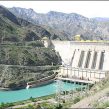
Hydroelectricity or Irrigation: a Central Asian Dilemma
Publication: Eurasia Daily Monitor Volume: 5 Issue: 229
By:

A regular lack of hydroelectric power during the winter in upstream Kyrgyzstan and Tajikistan and shortages of water during the summer in downstream Uzbekistan and Kazakhstan are making it necessary that the Central Asian states find common grounds for long-term cooperation on water management in the Syr Darya basin.
Most possible solutions in the region are stalled, however, by the various governments’ disagreement over the status of the Syr Darya River. According to the UN law on the management of trans-border water resources, upstream countries are only allowed to trade services associated with water, such as release and storage, but not to sell the water itself as a commodity.
Kyrgyzstan, however, refuses to accept Uzbekistan’s demand to recognize the trans-border status of the Syr Darya. Uzbekistan, in turn, is reluctant to contribute to the construction of the 1,900 MW Kambarata-1 and 240 MW Kambarata-2 hydro-power plants in Kyrgyzstan, which would increase the efficiency of trans-border water usage.
Meanwhile, Uzbekistan’s growing irrigation needs require more water from Kyrgyzstan’s Toktogul Reservoir in the summer, which leaves an insufficient volume of water for generating electricity during cold periods. If Kambarata-1 and Kambarata-2 were built, Kyrgyzstan would be able to store enough water for irrigation purposes in Uzbekistan, without having to reduce its own production of hydro-energy. Bishkek, however, would also attain greater leverage over controlling water releases to downstream countries.
International experience in Africa, Asia, and North America has shown that trans-border water administration may take several decades to complete. A mutual agreement between states sharing common water resources on tariffs for water services by upstream countries is the main incentive for such systems. Once tariffs are agreed upon, it becomes much easier for upstream countries to find investors for the construction of new dams and hydroelectric plants.
The construction of Kambarata-2 will be expensive, with projected electricity rates amounting to 7 cents, higher than the regional average. Kyrgyzstan would need to cover the costs of production by selling water services to Uzbekistan. Due to high construction costs, the Kambarata plants are more a political investment, which, if successful, would promise joint prosperity and greater stability in the region.
Pervasive corruption in the hydro-energy sector in both Kyrgyzstan and Tajikistan is yet another hindrance to interstate cooperation. Both Kyrgyzglavenergo and Barki Tochik, the main regulators of water resources, are headed by political officials with close ties to the two presidents; and the decision making in the hydro-energy sector is highly elitist and closed to the public. Top-ranking Kyrgyz and Tajik officials are involved in embezzlement and illegal sales of electricity, disregarding the deteriorating hydro-energy infrastructure. In Uzbekistan, a state monopoly of the cotton sector, the largest consumer of water from Syr Darya, and energy self-sufficiency make Uzbek decision makers uninterested in fostering regional solutions in water management.
There are only a few non-governmental leaders across Central Asia able to assess critically the efficiency and technical aspects of decisions made by the governments with regard to water management. The number of professionals inside the sector is declining as well, with most leading engineers having served since the Soviet period.
Yet, importantly, the current perception of water resources remains unchanged in Central Asia since the Soviet period: the various governments see themselves as monopolist managers of water resources, while the public is unaware of its right to influence the decision making. As part of the solution to the lack of public participation, it is imperative that mainstream water issues be reported in the local media and NGOs be involved in the decision making on a national and transnational level. Professionals from various backgrounds, including lawyers, engineers, sociologists, and economists, must initiate a public discussion on the future of water management. Such participation would change the old perceptions of water as one government’s commodity and increase transparency in setting policies.
In Kyrgyzstan, the lack of participation from the public and expertise among the NGOs has enabled President Kurmanbek Bakiyev to issue false reports continuously about developments in the sector. Bakiyev promised, for instance, that Kambarat-2 would soon be able to export energy abroad. Although the construction of Kambarata-2 has begun and the government has allocated funds to build it, no official construction plan has been made public. Furthermore, some local and international experts have pointed to the fact that Kambarata-2 would not be able to function properly in any case without the construction of Kambarata-1.
Lack of coordination in transnational water regulation contributes to the frustration among the Kyrgyz, Tajik, and Uzbek public. Although escalation of inter-state conflicts over water resources is unlikely, shortages of water and electricity will continue to damage local businesses and public health, while spawning local inter-ethnic conflicts.




